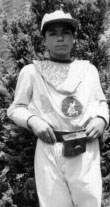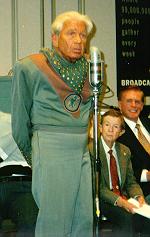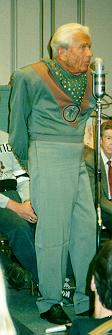Space Cadet
Briefing: Captain Video
More Captain Video
Tom Corbett
More Tom Corbett
Space Patrol
More Space Patrol Space Hero Files
Video Sources
"I Was There!"
Space Interviews
Space Reports Space Gallery
Space Album
Space Origins
Space Toy Box
Roaring Plastic
Serial Heroes The 1950s
Cosmic Feedback
Colliding Heroes
Space Stamps
Roaring Reviews
Space Awards Space Notice
Space Links <--Retro to
Main Page
 Allen Harris with his homemade Space Cadet uniform.
Allen Harris with his homemade Space Cadet uniform.
 Allen Harris with homemade spacesuit.
Allen Harris with homemade spacesuit.
 Chuck Lassen with his homemade space helmet,
circa 1952 (from a pattern in WOMAN'S DAY magazine!).
Chuck Lassen with his homemade space helmet,
circa 1952 (from a pattern in WOMAN'S DAY magazine!).


2005 Cosmic Correspondence
| January 05 | February 05 | July 05 | August 05 | December 05 |
|---|
| 2004 Archives | 2003 Archives | 2002 Archives | 2001 Archives |
|---|---|---|---|
| 2000 Archives | 1999 Archives | 1998 Archives |
 [From Claude Hayward (1/14/05):]
[From Claude Hayward (1/14/05):]
My stepfather, Al Ribas, was a Dumont TV studio engineer during the Captain Video era. Al came into my life in 1951, when I was six, and I don't know for how long he had been at Dumont before then. He had a place down in Greenwich Village, except now it would be called SoHo, properly, I think. My mom and I moved in there with him after they got married. At some point, while the show was still active, he took me into the studio and I got to see the spaceship, and the control board, which, I believe, Al built, or was involved in. After the show closed, he brought home Captain Video's ray gun, a clunky large all metal pistol that didn't do anything, painted a sort of gold color, very impressive. Wish now (of course) I had hung on to it, but I can still picture it perfectly in my mind. Around the muzzle were stacked disks, and another set or two of them closer to the grip. Course, I haven't seen it in almost fifty years, who knows what my memory may have twisted around. Any chance there is a photo of it somewhere in the archive? It was a sad day for me as a child when I saw Al Hodges in a dentist's suit, selling toothpaste on TV, after Captain Video closed down. Big disillusionment, and I felt bad for him, although I never met him. Dumont pioneered all sorts of stuff. They actually dragged cameras down into the streets and did some kind of noir night show live. Might have been called "Dark of Night" iirc. And, of course, Steve Allen, and the birth of late-night talk TV. Claude HaywardReturn to Top

 [From Norman Cherkis (2/6/05):]
[From Norman Cherkis (2/6/05):]
I just ran across your site on old space programs. It brought great smiles to my face, because, growing up in NY (actually, a small planet nearby [Brooklyn], I was a fan of those programs, especially those shot at the old Wannemaker Building and the WABD studios. In those days, I wanted to work in TV (never did) but that's another story. A couple of friends and I used to head down for the shows, done live, and used to collect the scripts. Unfortunately, the Captain Video scripts went out with my comic book collection after I left home. If only I had them now. However, looking at the Capt Video list inspired me to find my old autograph book and I've found (in order in the book) the autographs of:Return to TopCheck these out if you want to corroborate my enfeebled memory. This autograph book had a lot of traffic since I went to all kinds of shows to watch live broadcasts. Also at Wannamaker was the Johnny Olsen show. Got Herb Shriner, the 20 Questions folks (Fred Van Devanter, Florence Renard, John McPhee.) Got Art Carney, Blance Revisse, Sammy Speer, June Taylor from the Gleason show. It goes on and on. I can't remember breakfast but I still know how tsunamis work, plates move, what the floor of the Arctic Ocean looks like. And, BTW, Don Hastings' older brother, Bob, was also Archie Andrews on the radio. Have a great week, and thanks for the memories. NormReynolds Evans: "Count Callisto"
Fred Scott: "Rogers 161" --He actually lived in New Hyde Park, just across the road from the NYC line. My wife (whom I didn't know at the time) lived four houses down, on Patten Blvd.
Al Hodge: "Capt Video" (the second one)
Pat Fay: producerEd Condit (he was a WABD announcer, who later committed suicide)
Ruth White: Mrs Bullfinch
Tom McDermott: "Permes Lykos" AND "Kondar"
Gerrianne Raphael: Rhoda the Space Girl
Don Hastings: Video Ranger
Olga Druce: another producer
Malcolm Beggs: "Diamonds"
Dick Gander: "Joe Gentry"
George Cotton: "Mac"
Ben Lackland: "Commissioner Carey"
Ray Boyle: "Luny O'Brien"
Charles Medwick [Mendick?] : "Lisbon Charley" (I think he was a real Brit)
Stuart Bradley: "Cochran" (but also as Prince Percival from "The Magic Cottage," aired from the same studio -- with Pat Meikle)
Jim Boles: "Tarac"
Chester Stratton: "Jet Johnson"
Billy M. Green: "Skrag"
Wright King: "Johnnie Bascom"
Mary Vallee: "Luna McRorrie" (sister of Rocket McRorrie?)
Gloria Stroock: "Vially(?)"
Carl King: "Lt. Bailey 133"

 [From Ron Buck (7/3/05):]
[From Ron Buck (7/3/05):]
Love your site. I was 10 in 1950 and was a fan of all three of the space operas: Captain Video, Tom Corbett Space Cadet, and Space Patrol. I would like to add some information to the site with respect to Captain Video. The Galaxy was not Captain Video's first space ship. The first ship was the X-9. The set for this ship was incredibly crude. It consisted of a console set in the corner of a room and a stool. The console had a video tube in the middle and dials on each side. That was it. At least one of the Captain Video comic books showed the bridge of the X-9 with this console. The X-9 eventually crashed on the asteroid Pallas. Eventually it was replaced by the Galaxy, which had a greatly superior set, with a much more realistic looking bridge and one or more additional cabins. As I mentioned, the way the X-9 set was replaced was by having it crash on the asteroid Pallas. The X-10 was built on Pallas to get the Captain and Ranger back home. When the X-9 crashed on Pallas it turned out to be hollow and there were people in suspended animation (the sleepers of Pallas) in it, who the crash woke up. They built the X-10 for the Captain. I believe that the only thing the X-10 was used for was to get the Captain and Ranger back to Earth and shortly after he got home, he got the Galaxy. A clever way of replacing an extremely crude set with a significantly better one. Another interesting detail. In one episode Pluto had a moon. This was, I'm quite sure, before astronomers had discovered that Pluto indeed had a moon. Initially the radio beacon was on the side of a mountain. Later it was moved up to the top of a mountain. Commissioner Cary was not the first commissioner. Before him Captain Video's civilian superior was Commissioner Bell. The first time I ever heard about a transistor was on one of the Captain Video programs, where it played a role in one of the stories. The asteroid Ceres was referred to as a planet in one of the episodes. Here is another detail from one of the episodes that you may be interested in. This is the episode in which Pluto had a moon. The Captain was on Pluto looking for the missing "John Smith." His clue was a poem that ended "and by Pluto I'll find John Smith." "By Pluto" was thought to be an emotional expression like "by George." But the Captain solved the mystery by figuring out that "by Pluto" referred to Pluto's moon, since it is by Pluto. Incidentally John Smith turned out to be woman; the name was actually Joan Smith. Also one comment on Tom Corbett. The Space Academy had a typewriter (I think it was called a "teletypewriter") with a microphone connected to it. When someone spoke into the microphone the typewriter would type what was spoken into the microphone by itself. Hope you can use some of this information. Incidentally, I think the best science fiction from that era was the 1952 movie "The Day the Earth Stood Still." I have seen this on television in recent years and it is still impressive. Roland BuckReturn to Top

 [From Randy King (8/13/05):]
[From Randy King (8/13/05):]
What a great site! I'm about to finish my 53rd year on the planet and am one of those kids who wanted desperately to hop on board with Corbett and the others. I was thinking about a small tattoo that would sum up the wonder of my chilhood, searching for images and stumbled on your site. It's a gold mine! My humble thanks for such a rich treasure of the things that gave my generation wide-eyed hopes and fantasies of the future. Okay, so we don't have flying cars but we do have your link to invaluable memories. I'll take that over flying cars any day of the week. Thanx again for your important work... Randy KingReturn to Top

 [From Dave (12/15/2005):]
[From Dave (12/15/2005):]
Thanks for triggering a wonderful avalanche of remembrance. The late 40ís/ early 50ís were a magic time of Sci-Fi discovery and adventure for me. My most prized possessions were an anthology of SF short stories plus the double novel "When Worlds Collide" and "After Worlds Collide." Listening to SF anthologies on the radio and watching the old serials/movies at the theater on Saturday morning was a way of life then. Of course all that was terribly primitive compared to current standards, yet it was a fun and exciting part of my growing up. Thank you, DaveReturn to Top
